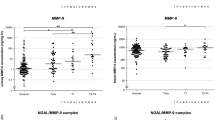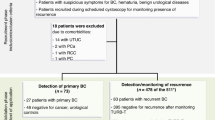Abstract
We investigated the feasibility of profiling and measuring the concentration of clusterin in urine and serum for individuals with transitional cell carcinoma (TCC) of the bladder and comparing it with nontumor controls. In addition, we analyzed the correlation of expression of clusterin in specimens of TCC to various clinicopathologic parameters and prognosis of bladder cancer. Blood and urine samples were used from 68 patients with TCC of the bladder and from 61 patients with benign urological diseases. Enzyme-linked immunosorbent assays (ELISA) were performed for clusterin from serum and urine. Quantitation of clusterin mRNA was carried out in 68 bladder tumor specimens from radical cystectomy or transurethral resection and 26 normal bladder specimens from BPH patients by using RT-PCR method. Correlation for the expression of clusterin mRNA with clinicopathologic parameters was analyzed. Serum and urine clusterin was significantly higher in individuals with bladder cancer than control (p = 0.001). Sensitivity and specificity of serum and urine clusterin as a tumor marker for TCC of the bladder was found to be 80%, 91%, 87.1% and 96.7% respectively. Clusterin expression was significantly higher in TCC specimens than normal tissue specimens (P < 0.001). Expression of clusterin was significantly higher in patients with invasive TCC of the bladder than that in patients with superficial TCC and control (P < 0.001). Overexpression of clusterin mRNA was significantly associated with tumor recurrence and overall survival (p < 0.001). The recurrence-free survival time of patients with overexpression of clusterin was significantly shorter than that of patients with weak expression of clusterin (9.8 months vs. 35.2 months). Clusterin may be considered as a potential diagnostic and prognostic biomarker for bladder cancer using urine, serum and/or molecular biology techniques.


Similar content being viewed by others
References
Irani J, Heidenreich A, Mottet N et al (2008) What is new in bladder cancer diagnosis and management? Eur Urol supplements 7:484–493
Haitel A, Posch B, El-Baz M et al (2001) Bilharzial related organ confined muscle-invasive bladder cancer: prognostic value of apoptosis markers, proliferation markers, p53, e-cadherin, epidermal growth factor receptor and c-erbB-2. J Urol 165:1481–1487
Millan-Rodriguez F, Chechile-Toniolo G, Salvador-Bayarri J et al (2000) Primary superficial bladder cancer risk groups according to progression, mortality and recurrence. J Urol. 164:680–684
Cajulis RS, Haines GK 3rd, Frias-Hidvegi D et al (1995) Cytology, flow cytometry, image analysis, and interphase cytogenetics by fluorescence in situ hybridization in the diagnosis of transitional cell carcinoma in bladder washes: a comparative study. Diagn. Cytopathol. 13(3):214–224
Schmitz-Dräger BJ, Fradet Y, Grossman HB (2008) Bladder cancer markers in patient management: the current perspective. World J Urol 26:1–3
Blaschuk O, Burdzy K, Fritz IB (1983) Purification and characterization of a cell-aggregating factor (clusterin), the major glycoprotein in ram rete testis fluid. J Biol Chem. 258:7714–7720
Jenne DE, Tschopp J (1992) Clusterin: the intriguing guises of a widely expressed glycoprotein. Trends Biochem Sci. 17:154–159
Jones SE, Jomary C (2002) Clusterin. Int J Biochem Cell Biol. 34:427–431
Shannan B, Seifert M, Leskov K et al (2006) Challenge and promise: roles for clusterin in pathogenesis, progression and therapy of cancer. Cell Death and Differentiation J. 13:12–19
Parczyk K, Pilarsky C, Rachel U et al (1994) Gp80 (Clusterin: TRPM-2) mRNA levels is enhanced in human renal clear cell carcinomas. J Cancer Res Clin Oncol 120:186–188
Steinberg J, Oyasu R, Lang S et al (1997) Intracellular levels of SGP-2 (Clusterin) correlate with tumor grade in prostate cancer. Clin Cancer Res 3:1707–1711
Redondo M, Villar E, Torres-Muñoz J et al (2000) Overexpression of Clusterin in human breast carcinoma. Am J Pathol 157:393–399
Miyake H, Gleave M, Kamidono S et al (2002) Overexpression of clusterin in transitional cell carcinoma of the bladder is related to disease progression and recurrence. Urology 50:150–154
Krüger S, Mahnken A, Kausch I et al (2006) Value of clusterin immunoreactivity as a predictive factor in muscle-invasive urothelial bladder carcinoma. Urology 67(1):105–109
Epstein JI, Amin MB, Reuter VR et al (1998) The World Health Organization/International Society of Urological Pathology consensus classification of urothelial (transitional cell) neoplasms of the urinary bladder. Am J Surg Pathol 22:1435–1448
Park J, Park J, Ju S et al (2003) Clusterin mRNA expression in apoptotic and activated rat thymocytes. Cell Research 13(1):49–58
Petrie A, Sabin C (2005) Medical Statistics at a Glance. 2nd ed.,Blackwell Publishing
Trougakso IP, So A, Jansen B et al (2004) Silencing expression of the clusterin/apolipoprotein J gene in human cancer cells using small interfering RNA induces spontaneous apoptosis, reduced growth ability, and cell sensitization to genotoxic and oxidative stress. Cancer Res. 64:1834–1842
Gleave M, Miyake H (2005) Use of antisense oligonucleotides targeting the cytoprotective gene, clusterin, to enhance androgen- and chemo-sensitivity in prostate cancer. World J. Urol. 23:38–46
Wong P, Ulyanova T, Organisciak DT et al (2001) Expression of multiple forms of clusterin during light-induced retinal degeneration. Curr Eye Res 23:157–165
Leskov KS, Klokov DY, Li J et al (2003) Synthesis and functional analyses of nuclear clusterin, a cell death protein. J. Biol. Chem. 278:11590–11600
Pucci S, Bonanno E, Pichiorri F et al (2004) Modulation of different clusterin isoforms in human colon tumorigenesis. Oncogene 23:2298–2304
Chen X, Halberg RB, Ehrhardt WM et al (2003) Clusterin as a biomarker in murine and human intestinal neoplasia. Proc. Natl. Acad. Sci. USA 100:9530–9535
Saffer H, Wahed A, Rassidakis GZ et al (2002) Clusterin expression in malignant lymphomas. Mod. Pathol. 15:1221–1223
Stejskal D, Fiala RR (2006) Evaluation of serum and urine clusterin as a potential tumor marker for urinary bladder cancer. Neoplasma. 53(4):343–346
Miyake H, Hara I, Gleave ME et al (2004) Protection of androgen dependent human prostate cancer cells from oxidative stress-induced DNA damage by overexpression of clusterin and its modulation by androgen. Prostate 61:318–323
Zellweger T, Kiyama S, Chi K et al (2003) Overexpression of the cytoprotective protein clusterin decreases radiosensitivity in the human LNCaP prostate tumour model. BJU Int. 92:463–469
Scaltriti M, Brausi M, Amorosi A (2004) Clusterin (SGP-2, APOJ) expression is downregulated in low- and high-grade human prostate cancer. Int. J. Cancer 108:23–30
July LV, Beraldi E, So A et al (2004) Nucleotide-based therapies targeting clusterin chemosensitized human lung adenocarcinoma cells both in vitro and in vivo. Mol. Cancer Ther. 3:223–232
Zhang LY, Ying WT, Mao YS (2003) Loss of clusterin both in serum and tissue correlates with the tumorigenesis of oesophageal squamous cell carcinoma via proteomic approaches. World J Gastroenterol 9:650–654
Xie MJ, Motoo Y, Su SB et al (2002) Expression of clusterin in human pancreatic cancer. Pancreas 25:234–238
Miyake H, Hara I, Kamidono S et al (2001) Synergistic chemosensitization and inhibition of tumor growth and metastasis by the antisense oligodeoxynucleotide targeting clusterin gene in a human bladder cancer model. Clin Cancer Res 7:4245–4252
Miyake H, Nelson C, Rennie PS et al (2000) Acquisition of chemoresistant phenotype by overexpression of the antiapoptotic gene, testosterone-repressed prostate message-2, in prostate cancer xenograft models. Cancer Res 60:2547–2554
Miyake H, Chi KN, Gleave ME (2000) Antisense TRPM-2 oligodeoxynucleotides chemosensitize human androgenindependent PC-3 prostate cancer cells both in vitro and in vivo. Clin Cancer Res 6:1655–1663
Miyake H, Hara I, Kamidono S et al (2001) Novel therapeutic strategy for advanced prostate cancer using antisense oligodeoxynucleotides targeting antiapoptotic genes up-regulated after androgen withdrawal to delay androgen-independent progression and enhance chemosensitivity. Int J Urol 8:337–349
Author information
Authors and Affiliations
Corresponding author
Rights and permissions
About this article
Cite this article
Hazzaa, S.M., Elashry, O.M. & Afifi, I.K. Clusterin as a Diagnostic and Prognostic Marker for Transitional Cell Carcinoma of the Bladder. Pathol. Oncol. Res. 16, 101–109 (2010). https://doi.org/10.1007/s12253-009-9196-3
Received:
Accepted:
Published:
Issue Date:
DOI: https://doi.org/10.1007/s12253-009-9196-3




